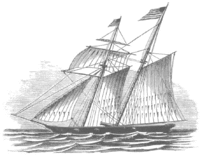
A privateer is a private person or vessel which engages in maritime warfare under a commission of war. Since robbery under arms was a common aspect of seaborne trade, until the early 19th century all merchant ships carried arms. A sovereign or delegated authority issued commissions, also referred to as letters of marque, during wartime. The commission empowered the holder to carry on all forms of hostility permissible at sea by the usages of war. This included attacking foreign vessels and taking them as prizes and taking crews prisoner for exchange. Captured ships were subject to condemnation and sale under prize law, with the proceeds divided by percentage between the privateer's sponsors, shipowners, captains and crew. A percentage share usually went to the issuer of the commission.

The War of Jenkins' Ear was a conflict lasting from 1739 to 1748 between Britain and Spain. The majority of the fighting took place in New Granada and the Caribbean Sea, with major operations largely ended by 1742. It was related to the 1740 to 1748 War of the Austrian Succession. The name was coined in 1858 by British historian Thomas Carlyle, and refers to Robert Jenkins, captain of the British brig Rebecca, whose ear was allegedly severed by Spanish coast guards while searching his ship for contraband in April 1731.
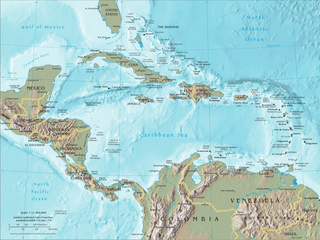
The era of piracy in the Caribbean began in the 1500s and phased out in the 1830s after the navies of the nations of Western Europe and North America with colonies in the Caribbean began hunting and prosecuting pirates. The period during which pirates were most successful was from the 1650s to the 1730s. Piracy flourished in the Caribbean because of the existence of pirate seaports such as Port Royal in Jamaica, Tortuga in Haiti, and Nassau in the Bahamas. Piracy in the Caribbean was part of a larger historical phenomenon of piracy, as it existed close to major trade and exploration routes in almost all the five oceans.
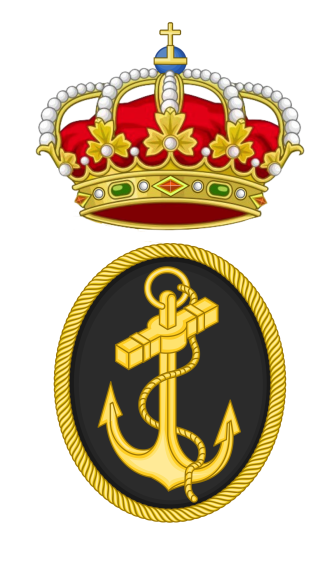
The Spanish Navy or officially, the Armada, is the maritime branch of the Spanish Armed Forces and one of the oldest active naval forces in the world. The Spanish Navy was responsible for a number of major historic achievements in navigation, the most famous being the discovery of America and the first global circumnavigation. For several centuries, it played a crucial logistical role in the expansion and consolidation of the Spanish Empire, and defended a vast trade network across the Atlantic Ocean between the Americas and Europe, and the Manila Galleon across the Pacific Ocean between the Philippines and the Americas.
The term Carthaginian usually refers to the civilisation of ancient Carthage.

Juan José Ruiz de Apodaca y Eliza, 1st Count of Venadito, OIC, OSH, KOC was a Spanish Navy officer, nobleman and colonial administrator who served as the viceroy of New Spain from 20 September 1816 to 5 July 1821 during the Mexican War of Independence.
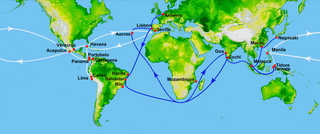
The Spanish treasure fleet, or West Indies Fleet, was a convoy system of sea routes organized by the Spanish Empire from 1566 to 1790, which linked Spain with its territories in the Americas across the Atlantic. The convoys were general purpose cargo fleets used for transporting a wide variety of items, including agricultural goods, lumber, various metal resources such as silver and gold, gems, pearls, spices, sugar, tobacco, silk, and other exotic goods from the overseas territories of the Spanish Empire to the Spanish mainland. Spanish goods such as oil, wine, textiles, books and tools were transported in the opposite direction.
Prize money refers in particular to naval prize money, usually arising in naval warfare, but also in other circumstances. It was a monetary reward paid in accordance with the prize law of a belligerent state to the crew of a ship belonging to the state, either a warship of its navy or a privateer vessel commissioned by the state. Prize money was most frequently awarded for the capture of enemy ships or of cargoes belonging to an enemy in time of war, either arrested in port at the outbreak of war or captured during the war in international waters or other waters not the territorial waters of a neutral state. Goods carried in neutral ships that are classed as contraband, being shipped to enemy-controlled territory and liable to be useful to it for making war, were also liable to be taken as prizes, but non-contraband goods belonging to neutrals were not. Claims for the award of prize money were usually heard in a prize court, which had to adjudicate the claim and condemn the prize before any distribution of cash or goods could be made to the captors.

Louis-Michel Aury was a French privateer operating in the Gulf of Mexico and the Caribbean during the early 19th century.
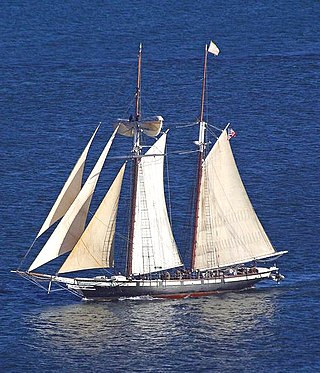
A Baltimore clipper is a fast sailing ship historically built on the mid-Atlantic seaboard of the United States, especially at the port of Baltimore, Maryland. An early form of clipper, the name is most commonly applied to two-masted schooners and brigantines. These vessels may also be referred to as Baltimore Flyers.

Nicholas van Hoorn was a merchant sailor, privateer and pirate. He was born in the Netherlands and died near Veracruz after being wounded on the Isla de Sacrificios. Nikolaas or Klaas was engaged in the Dutch merchant service from about 1655 until 1659, and then bought a vessel with his savings. With a band of reckless men whom he had enlisted, he became a terror to the commerce of the Dutch Republic and the Spanish Empire. Later he had several ships in his employment and obtained such notoriety that some governments were willing to employ him against their enemies.
USS Gallatin was a post-Revolutionary War sailing vessel that the U.S. Department of the Treasury purchased at Norfolk, Virginia, for the United States Revenue-Marine in December 1807. An explosion on board destroyed her in 1813.
The Post Office Packet Service dates to Tudor times and ran until 1823, when the Admiralty assumed control of the service. Originally, the Post Office used packet ships to carry mail packets to and from British embassies, colonies and outposts. The vessels generally also carried bullion, private goods and passengers. The ships were usually lightly armed and relied on speed for their security. However, Britain was at war almost continuously during the 18th and early 19th centuries with the result that packet ships did get involved in naval engagements with enemy warships and privateers, and were occasionally captured.

The Spanish American wars of independence took place across the Spanish Empire in the early 19th century. The struggles in both hemispheres began shortly after the outbreak of the Peninsular War, forming part of the broader context of the Napoleonic Wars. The conflict unfolded between the royalists, who were defeated and favored a unitary monarchy, and the patriots, who won and promoted either plural monarchies or republics, separated from Spain and from each other. These struggles ultimately led to the independence and secession of continental Spanish America from metropolitan rule, which, beyond this conflict, resulted in a process of Balkanization in Latin America. Thus, the strict period of military campaigns ranges from the Battle of Chacaltaya (1809) in present-day Bolivia, to the Battle of Tampico (1829) in Mexico.
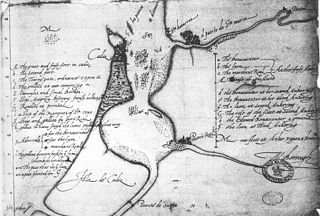
Singeing the King of Spain's Beard is the derisive name given to a series of attacks by the English privateer Francis Drake against the Spanish in the summer of 1587, beginning in April with a raid on Cádiz. This was an attack on the Spanish naval forces assembling in the Bay of Cádiz in preparation for the planned expedition against England. Much of the Spanish fleet was destroyed, and substantial supplies were destroyed or captured. There followed a series of raiding parties against several forts along the Portuguese coast. A Spanish treasure ship, returning from the Indies, was also captured. The damage caused by the English delayed Spanish preparations for the Armada by at least a year.

HMS Sappho was a Cruizer class brig-sloop built by Jabez Bailey at Ipswich and launched in 1806. She defeated the Danish brig Admiral Yawl in a single-ship action during the Gunboat War, and then had a notably successful two months of prize-taking in the first year of the War of 1812. She was wrecked in 1825 off the Canadian coast and then broken up in 1830.

Cartagena Province, also called Gobierno de Cartagena during the Spanish imperial era, was an administrative and territorial division of New Granada in the Viceroyalty of Peru. It was originally organized on February 16, 1533 as a captaincy general from the central portion of the Province of Tierra Firme. In 1717, King Philip V of Spain issued a royal decree creating the Viceroyalty of New Granada, by which the province was added to the latter.

The Battle of the Strait of Gibraltar was a naval action off Gibraltar on 24th of April, 1591. A fleet of three English merchant vessels escorted by a larger armed merchant vessel Centurion was attacked by five Spanish galleys. Ultimately, the Spanish were repelled, but not before the English vessel Dolphin was sunk by one of the galleys.

Amaro Rodríguez-Felipe y Tejera Machado, also known as Amaro Pargo, was a Spanish privateer and slave trader. He was one of the most well-known Spanish privateers during the Golden Age of Piracy. Pargo was noted for his commercial activities and for his frequent religious donations and aid to the poor. In his role as a privateer, he targeted trade routes between Cádiz and the Caribbean, on several occasions attacking British and Dutch merchant ships, earning recognition in his time as a hero and coming to be regarded as "the Spanish equivalent of Francis Drake". He was declared a Caballero hidalgo in 1725 and obtained certification of nobility and royal arms in 1727.
José Joaquim Almeida, was a Portuguese-born American privateer who fought in the Anglo-American War of 1812 and the Argentine War of Independence.

